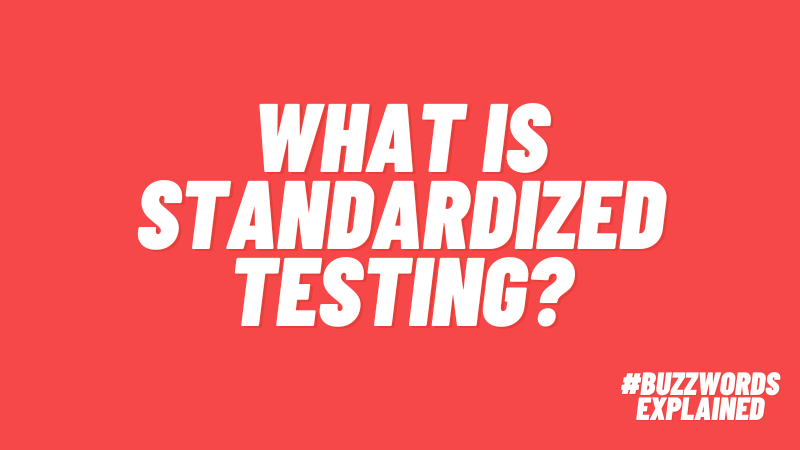Standardized testing is a hot-button topic, one that’s fraught with controversy. While these assessments have been around for decades, the increase in testing in the last 20 years or so has brought the issue to the forefront. As parents consider opting their students out and some states seek to do away with them, it’s worth asking: What exactly is standardized testing, and why do we focus on it so heavily?
What is standardized testing?

Source: StateImpact
In a standardized test, every student responds to the same questions (or questions from same question bank), under the exact same set of conditions. They are often made up of multiple-choice questions and are given on paper or (more commonly these days) on a computer. Experts choose the questions carefully to test a specific set of skills and knowledge.
Large groups of students take the same standardized tests, not just those in the same class or school. This gives people the chance to compare results across a specific group, usually children of the same age or grade level.
What are some types of standardized tests?
There are different types of standardized tests, including:
- Diagnostic test: These often help determine if a student qualifies for special education services. They can test academic, physical and fine motor skills, social and behavioral skills, and more. Examples might be a hearing test or a learning disability test.
- Achievement test: This type of test measures a student’s current strengths and weaknesses in a particular area, almost always academic subjects. Examples include the SAT, the Iowa Assessments, and the tests many states use at certain grade levels.
See a list of popular standardized tests here.
How are standardized tests scored?
Each individual standardized test has its own scoring mechanism. Usually, a student earns a score based on the number of correct answers they give. Those scores can be analyzed in two different ways: criterion-referenced and norm-referenced.
Criterion-Referenced Scoring
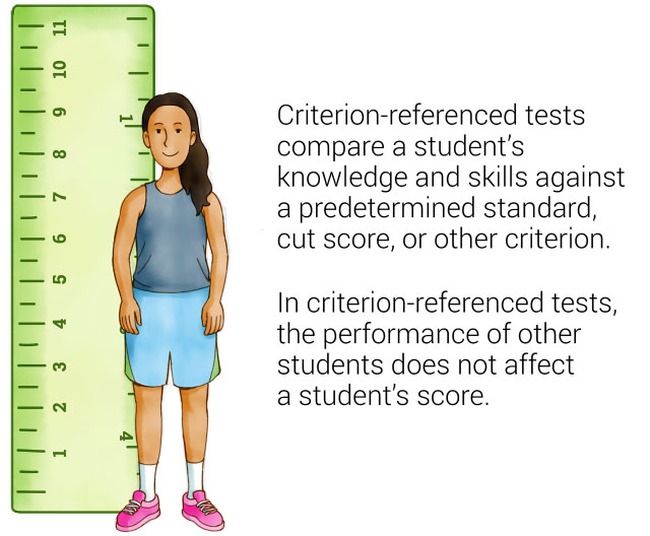
Source: Criterion-Based Testing/Renaissance
In this type of scoring, a student’s results are measured against predetermined standards, not against other test takers’ results. Their scores might help educators place them in categories like “proficient,” “advanced,” or “deficient.”
Advanced Placement (AP) exams are an excellent example of criterion-referenced tests. Students earn a score on a 5-point scale, with 5 being the highest. They earn these scores based on preset standards. Students aren’t ranked in comparison to one another.
Another example would be a driver’s license test. Students pass or fail based on their answers, with no reference to how others score. Criterion-referenced tests help measure a student’s personal achievements, regardless of their age or grade level.
Norm-Referenced Scoring
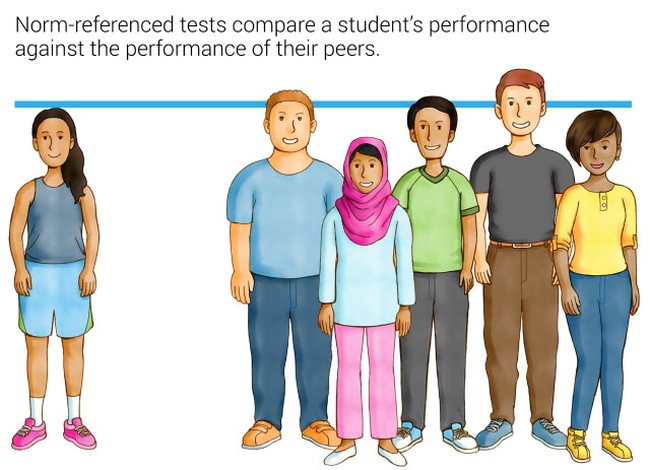
Source: Norm-Based Testing/Renaissance
In norm-referenced tests, students are ranked based on their scores. This places them into “percentiles,” which measure how they performed compared to their peers. If a student is in the 58th percentile, it means they scored higher than 58% of all the students who took the exam. It’s usually better to rank in a higher percentile.
Most state standardized tests are norm-referenced, as are IQ tests. A student can perform well on a test, but if their peers performed better, they will still be ranked in a lower percentile. These scores are ranked on a bell curve.
You can think of norm-referenced tests the same way you might think of a growth chart at the doctor’s office. Doctors know the average height for a child at a certain age. They can then compare a specific child to those averages, to determine if they are shorter or taller than average.
Learn more about criterion-referenced vs. norm-referenced tests here.
What are standardized tests used for?
Standardized tests are meant to give educators a chance to determine how effective their instruction strategies are overall. They can also help identify strengths and weaknesses in students, so these students can receive individualized attention as needed. Many consider them an important way to be sure all students across a state or even the nation are learning to the same basic educational standards.
The Elementary and Secondary Education Act of 1965 first required schools to use standardized tests. This act provided funding to schools to ensure every student had access to equal education opportunities, and used standardized tests to determine how schools were performing against national averages. The No Child Left Behind Act of 2001 ramped up standardized testing even further. It tied some federal funding to student test scores, and raised the stakes for schools dramatically.
The Every Student Succeeds Act of 2015 currently requires annual statewide tests in reading/language arts and mathematics to all students in grades 3-8 and once during the high school years. States also must test on science at least once in each of grades 3-5, 6-9, and 10-12.
What are the benefits to standardized testing?
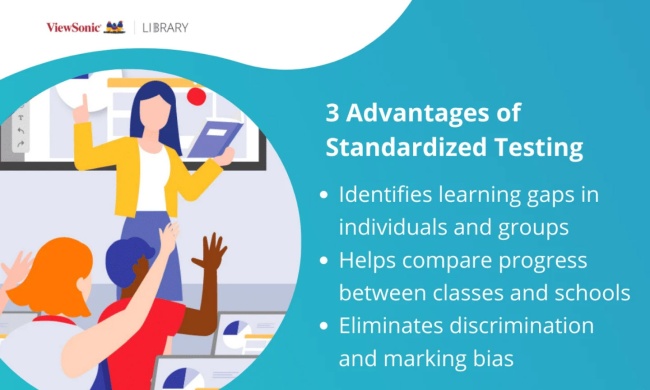
Source: ViewSonic
Proponents of standardized tests consider these factors to be among the benefits:
- Standardization of quality curriculum: By requiring standardized tests, schools across the country can be sure they’re teaching the basic skills and knowledge every student needs at specific ages. Experts determine the skills and knowledge they feel will equip students to succeed in the larger world after they graduate.
- Equality and equity: Lower-income populations have long been underserved by traditional educational systems. By requiring all schools to meet the same educational standards, as measured by tests, education becomes more equitable for all.
- Removal of bias: When computers or impartial graders score tests objectively, it eliminates potential bias. (This assumes the test writers created non-biased questions.)
- Measure of effective instruction: High-ranking schools may be able to share their instruction methods with those who rank lower, encouraging ingenuity and cooperation across the system. Tests can determine where teachers may need more training, or where additional funding could help schools improve their programs.
Learn about more potential benefits of standardized testing here.
What are some drawbacks of standardized testing?
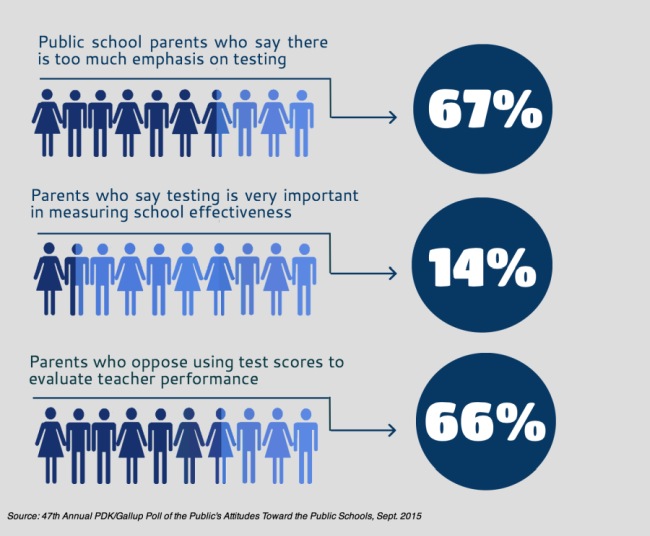
Source: NEA
Despite the potential benefits, the backlash against increased testing has become louder in recent years. Teachers, students, and parents worry about many factors, including:
Over-Testing
In a nationwide study of the largest urban schools, students took an average of 112 standardized tests from kindergarten through graduation. Students may spend as many as 19 hours or more taking these tests each year. And this doesn’t include time spent on test prep or practice tests.
What’s more, teachers often note that standardized tests don’t match up with their textbooks or other materials. Sometimes they don’t even match the state educational standards. And even when they do, the standards may not be particularly relevant or useful for every student.
Learn why teachers wish they had more involvement in standardized test development.
Test Anxiety
Taking a test is never a laid-back process, and never more so than during standardized tests. Students are scrutinized from all angles to make sure they don’t cheat. Teachers have to perform that scrutiny and often undergo some of it themselves.
There’s so much pressure to do well on these tests that kids can feel like it’s a life-or-death situation. Their anxiety goes through the roof, and even those who know the material thoroughly may not perform well under the pressure. And more and more districts evaluate teachers based at least in part on student test scores. This can affect their salaries and chances for advancement.
More Kids Than Ever Are Dealing With Test Anxiety, and We Need to Help
Lost Instructional Time
With days lost to taking tests, not to mention all the time spent preparing, other educational aspects fall by the wayside. Teachers lose the chance to give students more meaningful hands-on experiences. They eliminate unique and engaging projects or activities that don’t directly relate to items included on tests. As the saying goes, they “teach to the test,” and nothing more.
Read what one teacher would really like to tell their students about benchmark testing.
Lack of Useful Data
Many teachers will tell you that they can predict almost exactly how their students will score on the standardized assessments. In other words, these tests aren’t giving them any new information. Teachers already know which students are struggling and which have mastered the necessary skills and knowledge. Generated data rarely seems to provide any useful direct benefits to teachers or students.
See the 7 Biggest Complaints Teachers Have About Testing—and How to Fix Them.
Still have more questions about standardized testing? Join the WeAreTeachers HELPLINE group on Facebook to chat with other educators.
Plus, These Test-Taking Strategies Will Help Students Pass With Ease.

